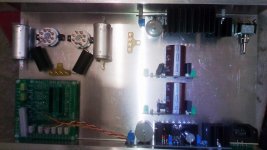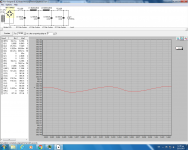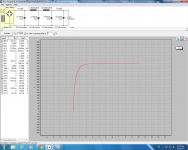Something with 150-200H @ 20mA & 600 Ohm output I guess. As for ratio keep in mind that you start with 20dB max available when choke loaded. 15.5dB for resistive load. THD gets seriously better with inductive load as the signal swing increases.
So the 6V6 circuit remained the same with line output transformer??
What is the primary impedance? 10K? or higher?
But 200H seems to be tough except go to parafeed.
Hi Salas!!
What is your comment about 6V6 vs DCG3?
I have your SSHV2 regulator.
Thanks!
6V6 great for tube tone on load 20K or up, big sound
DCG3 great for studio tone on any load, more resolution less bloom, big sound still
So the 6V6 circuit remained the same with line output transformer??
What is the primary impedance? 10K? or higher?
But 200H seems to be tough except go to parafeed.
10k would be good
10k would be good
I want to give this line output transformer a try, and this is wound with single crystal copper amorphous core.
https://world.taobao.com/item/81948...spm=a312a.7700824.w4002-13163244193.26.uyvxzu
However, not sure whether the inductance 200H or above. Is 200H inductance a must?
How can i get your 6V6 circuit with line output transformer??
You build the gain type circuit (common cathode 1st published one) and instead of anode resistor you place the transformer's primary. When its 10K it should have enough inductance. The 150Ω output impedance is great but the 0:13 ratio is going to leave you with little if any gain in this preamp. Maybe 1x-1.5x. Double that for balanced secondaries output using an XLR. That's good for blocking microphonic noises etc. but make sure that you don't need substantial line gain in your system.
So the Raphealite 10K output transformer stated in my previous message is adequate, right?
The secondary is 150+150, and it should be 600 ohm.
Also, I found your circuit from this link.
http://basaudio.net/blog/wp-content/uploads/2012/06/Salas6V6LineStage.jpg
If the 10K line output transformer is in used, the 0.68uf cap is no longer needed, right?
What about the B+ voltage? Still 340v??
Finally, can I have the SSHV2 for 340v regulation??
Thanks!
The secondary is 150+150, and it should be 600 ohm.
Also, I found your circuit from this link.
http://basaudio.net/blog/wp-content/uploads/2012/06/Salas6V6LineStage.jpg
If the 10K line output transformer is in used, the 0.68uf cap is no longer needed, right?
What about the B+ voltage? Still 340v??
Finally, can I have the SSHV2 for 340v regulation??
Thanks!
You build the gain type circuit (common cathode 1st published one) and instead of anode resistor you place the transformer's primary. When its 10K it should have enough inductance. The 150Ω output impedance is great but the 0:13 ratio is going to leave you with little if any gain in this preamp. Maybe 1x-1.5x. Double that for balanced secondaries output using an XLR. That's good for blocking microphonic noises etc. but make sure that you don't need substantial line gain in your system.
If I have an amplifier that has input impedance around 0.5v input sensitivity for full output, I guess the gain should be fine, do you agree?
Has low or high input impedance? If it has high input impedance and so good sensitivity just make the cathode follower version and don't spend on output transformer. Those when good are very expensive and bulky items that it takes a very good technical reason to must be employed. Unless you believe in a transformer instead of an output capacitor for own esoteric reasons. Of course no output 0.68u is needed then, the transformer passes no DC. Does electromagnetic coupling. You can have any DC rail cleaner or regulator solution that is quiet enough and you like to build. SSHV is one of those, but its not entry level, takes some building and testing experience, can break easier than passive filtering or tube reg. Its solid state and fast having large bandwidth, can react or catch interference easier.
Has low or high input impedance? If it has high input impedance and so good sensitivity just make the cathode follower version and don't spend on output transformer. Those when good are very expensive and bulky items that it takes a very good technical reason to must be employed. Unless you believe in a transformer instead of an output capacitor for own esoteric reasons. Of course no output 0.68u is needed then, the transformer passes no DC. Does electromagnetic coupling. You can have any DC rail cleaner or regulator solution that is quiet enough and you like to build. SSHV is one of those, but its not entry level, takes some building and testing experience, can break easier than passive filtering or tube reg. Its solid state and fast having large bandwidth, can react or catch interference easier.
Sorry typo. What I want to ask whether amplifier with high sensitivity (0.5v full power) adequate for this 6V6 linestage with output transformer (10K)?
I prefer SSHV2 as I have it on hand. However, what I concern whether the 20H choke still necessary when good reg like the SSHV2 is in the rail?
Yes, I agree if the input impedance of amp has pretty high impedance, then cap coupling is the way to go. I have friend build a preamplifier with cathode follower to drive the Quad II amplifier that has 1.5M input impedance and has a great result!!
When its 10K it should have enough inductance. The 150Ω output impedance is great but the 0:13 ratio is going to leave you with little if any gain in this preamp. Maybe 1x-1.5x. Double that for balanced secondaries output using an XLR. That's good for blocking microphonic noises etc. but make sure that you don't need substantial line gain in your system.
So are you preferring I wire the the secondary of the 10K line output transformer in "balanced" for XLR?? Is wire in unbalanced no good at all??
Use a CRC. Or a CLC with much lower value choke than 20H. But with choke's mA spec > than the CCS setting if any choke will be used.
With 0.5V sensitivity, if 20k or more input impedance also, just make the capacitor coupled cathode follower. Transformer for 150Ω output impedance is not offering any better drive. Unless its an XLR amp and you need the transformer to drive long run of balanced cable.
With 0.5V sensitivity, if 20k or more input impedance also, just make the capacitor coupled cathode follower. Transformer for 150Ω output impedance is not offering any better drive. Unless its an XLR amp and you need the transformer to drive long run of balanced cable.
Salas,
Regarding the output transformer, it states that the maximum current capability is 20mA, is that ok for your 6V6?
https://world.taobao.com/item/81948...spm=a312a.7700824.w4002-13163244193.26.uyvxzu
Also, the 5K 10W resistor should be eliminated with output transformer?
Thanks!
Regarding the output transformer, it states that the maximum current capability is 20mA, is that ok for your 6V6?
https://world.taobao.com/item/81948...spm=a312a.7700824.w4002-13163244193.26.uyvxzu
Also, the 5K 10W resistor should be eliminated with output transformer?
Thanks!
The materials have been collected .
Now good mood for assembly .
The chassis is shaped Π with dimensions 38 Χ 20.5 Χ 7 cm, with future possibility of adding wood to the sides of the box.
My thought is the combination Cathode follower version with Arduino based LDR volume and source selection controller .
Now good mood for assembly .
The chassis is shaped Π with dimensions 38 Χ 20.5 Χ 7 cm, with future possibility of adding wood to the sides of the box.
My thought is the combination Cathode follower version with Arduino based LDR volume and source selection controller .
Attachments
Last edited:
- Home
- Amplifiers
- Tubes / Valves
- 6V6 line preamp



